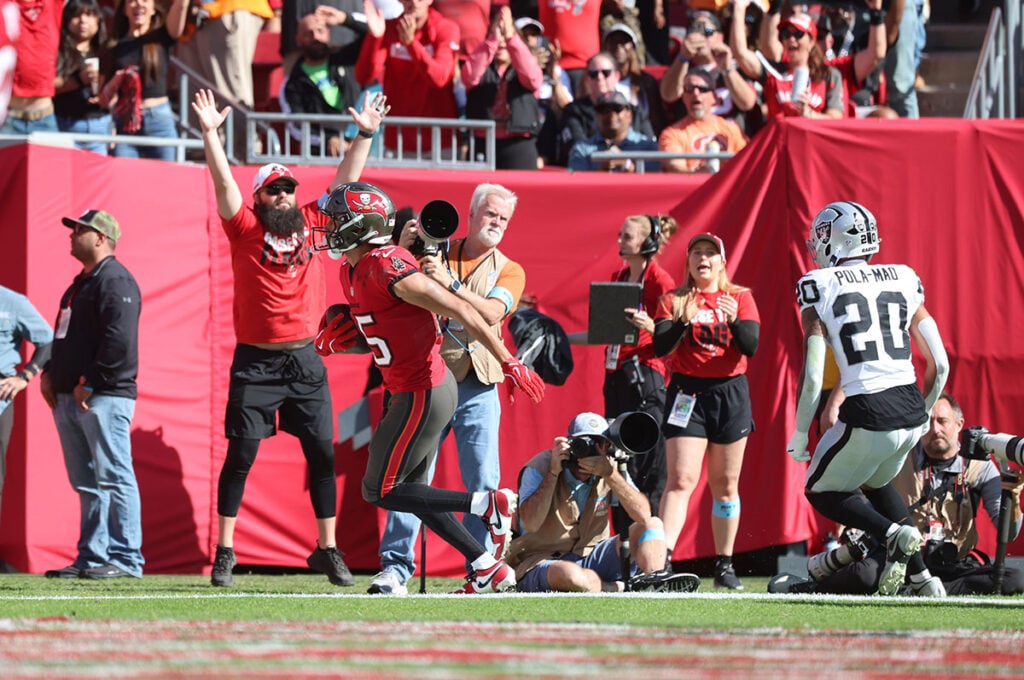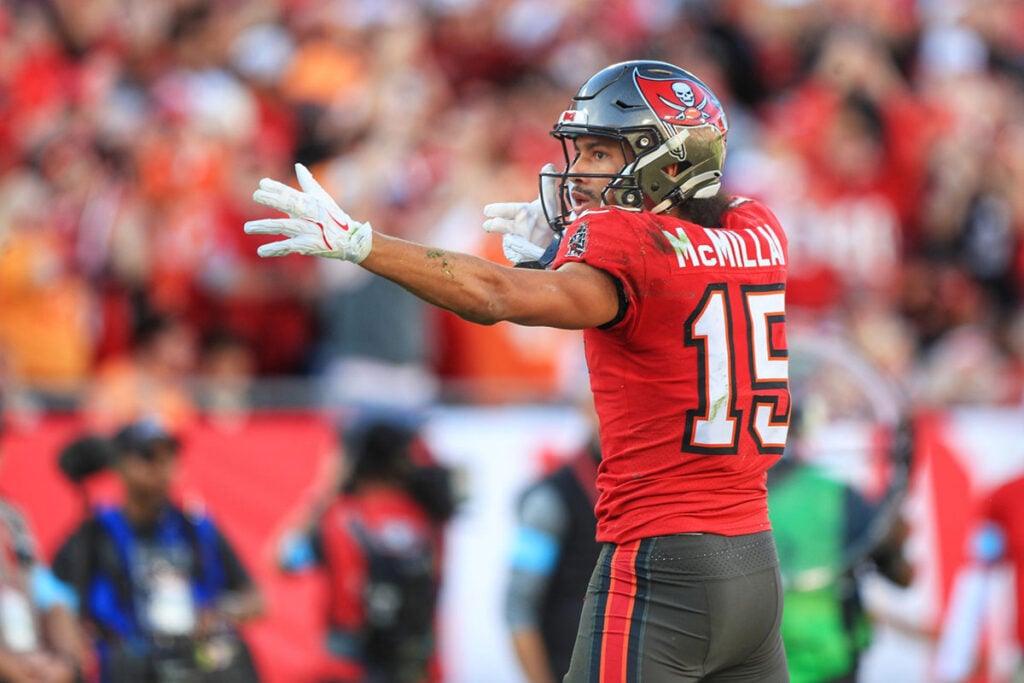It’s a big year for Jalen McMillan. After a hot training camp and a touchdown in his first regular season game last year, he cooled considerably through most of the season before going on an absolute tear down the stretch in 2024. Despite the arrow being up on the 2024 third-round pick, he finds himself in a fight for playing time as training camp has opened this week. Given the rollercoaster nature of McMillan’s rookie season, I went back and watched every route he ran last year to identify what he did well, what he improved on, how he fits in the offense and where he can go from here.
Bucs WR Jalen McMillan – Photo by: Jeffrey Jones/PR
McMillan’s Early Strengths
As I watched JMac over the course of the first half of the season there were two immediate strengths that really stood out to me consistently. The first was apparent trait that helped the Bucs was his ability to win deep. He is not a burner by any means, but his 4.47 40-yard dash time is in the 61st percentile for his position group per Mockdraftables.
But what I found interesting with McMillan is how he gets to speed. He is more of a speed gatherer, with a slower build off the line, but really accelerating through the intermediate part of his route. By the time he is 15-25 yards down field he is moving faster than anyone expects. This allows him to get on top of safeties and deep third corners and win downfield.
Add to that a real crisp, snappiness to his breaks on out-breakers.
Jalen McMillan on the out-breaker. He displayed real conviction and precision on these routes from the start of the season to the end. pic.twitter.com/OcpXGxAfIJ
— Joshua Queipo (@josh_queipo) July 25, 2025
The Bucs leaned into this, asking him to run outs more often than any other route. Next Gen Stats has McMillan with a 73.3% catch rate and 1.81 yards per route run on out-breakers.
McMillan on the Corner Route pic.twitter.com/T1XSgqF4cN
— Joshua Queipo (@josh_queipo) October 26, 2024
Gaps In His Game
McMillan was not a complete receiver, which led to many of his early-season struggles. Key parts of his game were underdeveloped for the NFL. As good as he was running out-breakers, he lacked the same precision when attempting dig routes. His routes were rounded as he rolled into them. This put his timing off of the rhythm of the play. At other times he would add too many steps at the top of his stem, preventing him from releasing his break with power and speed. Compare his production on the out-breakers before with his 57.9% catch rate and 0.81 yards per route run on in-breakers.
A lack of play strength plagued McMillan’s game in several key areas. Against press-man coverage he would often struggle to beat jams. Even the threat of a strong punch from a corner caused him to over-correct his release and delay his route. Gaining separation against press was a real challenge for him resulting in just three catches on 51 routes run all year.
The play strength issues showed up in contested catch situations as well. Through the first eight games of the season McMillan failed to secure a single contested catch. What’s more, McMillan was a net negative as a blocker. His effort level wasn’t always 100%. When he was trying, his slight frame and poor ability to stay connected led to his block getting slipped on a regular basis. Through the front half of the season McMillan was graded as the worst blocking receiver on the team by Pro Football Focus – earning a 30.6 grade from the player evaluation site.
Second Half Improvements
It’s no secret that McMillan had a major turnaround following the Bucs’ week 11 bye. Over the final five weeks of the season, he racked up 24 catches for 316 yards and seven touchdowns and 1.90 yards per route run. This wasn’t a magical change in results with no change to the process. He made several notable improvements to his game that should give the team confidence as he enters year two.

Bucs WR Jalen McMillan – Photo by: USA Today
In-Breakers, The Middle Of The Field, And Contested Catches
McMillan must have worked hard on improving his route running through the mid-part of the season. Down the stretch JMac became much more precise with his stems and broke with more power and confidence.
Part of Jalen McMillan’s 2nd half improvements were centered around more conviction/crip route running on in-breakers like this deep dig route. pic.twitter.com/nWhzPVg2bY
— Joshua Queipo (@josh_queipo) July 23, 2025
Where his route tree was much more limited earlier in the season, at least the routes he was effective at running, as the season moved on his tree developed more and made him more dangerous, forcing defenses to have to account for him more. Coinciding with the improvements in his route running over the middle of the field came more aggression at the catch point. This led to McMillan’s contested catch rate going from nonexistent to a respectable 43%.
On a day where he had a long touchdown and several deep in-breaking catches, this is probably my favorite JMac play bc it shows growth for him in securing catch-on-collision throws. Arrow continues to be up on him.
Now 13th among all rookies in receiving yards. pic.twitter.com/U9YQrOnfyo
— Joshua Queipo (@josh_queipo) December 16, 2024
The improvements led to a difference in his usage. Curls went from 7% of his routes run in the first half of the season to 27% and his dig routes moved from 14% of his total routes to 23%.
JMac struggled to create separation vs. man coverage early LY outside of coverage busts created by scheme. But did a nice job of setting up this short in-breaker in week 7 vs. BAL. pic.twitter.com/RNNbyWQRkG
— Joshua Queipo (@josh_queipo) July 14, 2025
Helping Others
Remember when I said McMillan’s blocking was lacking early in the season. That was another area of his game that improved as the season wore on.
Among the many areas McMillan improved in throughout last year was his blocking. This is backed up by his PFF blocking grades.
Weeks 1-10: Team-worst (among WR’s) 32.7 grade
Weeks 11-18: 2nd-best among position group 58.3 grade pic.twitter.com/SbVqZrYbYj— Joshua Queipo (@josh_queipo) July 20, 2025
Gallons of virtual ink has been spilled lauding the Bucs for their run game improvements last year. Not nearly enough has noted the efforts of the receivers in helping spring long runs. JMac was a big part of that late in the year.
Other Notes
With Godwin out, McMillan got more opportunities in the Bucs’ screen game. He had a couple of nice plays, but I wouldn’t say this was a strength of his. As I mentioned earlier, he isn’t an explosive starter, and he doesn’t make defenders miss very often. He can glide forward, but unless he is at top speed, his cuts don’t throw defenders off balance enough. Only eight out of 72 receivers with at least 60 targets last year forced one missed tackle or less. McMillan was one of those eight.
He was at his most dangerous operating as the motion man in the offense. As a speed gatherer having him underway at the snap only helps pressure the defense more so.
McMillan’s skillset – even the improved skillset – still play perfectly for the role of the Z receiver in the Bucs offense. Keeping him off of the line of scrimmage and in motion so he doesn’t have to contend with as many jams plays to his strengths. With his improvements over the middle and in catch-on-collision situations he can have a larger role in the team’s bunch and stack packages. He is now a legitimate threat on two-way go’s and will have to be accounted for as such.

Bucs WR Jalen McMillan – Photo by: Cliff Welch/PR
The most interesting part of how he can keep himself on the field is his effectiveness as a deep threat. Outside of Trey Palmer, he had the highest percentage of his targets at 20+ air yards. And he was second to Mike Evans in deep targets, catches, yards and touchdowns on such throws. With the team finding a new unlock with Evans late in the year as more of an intermediate threat, McMillan is set to potentially become the team’s best deep threat going forward. His ability to modulate his speed through the route and run decoy verticals just as hard as when he is an early option in the progression.
After watching his whole body of work in 2024, I came away even more encouraged seeing real improvements in the process of his work even if some of the production he has been praised for was more empty calories. Despite that I still think his role is a bit limited in the offense meaning other pieces have to be in place to help him thrive. And his lack of versatility may prevent him from expanding his playtime from last year.